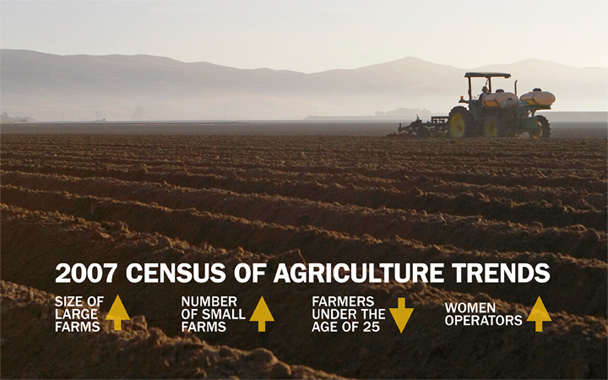The Department of Agriculture published the 2007 Agriculture Census last week. Amid hundreds of pages of graphs, charts, and statistics that range from national trends to state and county raw data, a few startling, potentially important signals emerged.
The post–World War II trend toward concentration in agriculture continued. There were 2,204,792 farms in the country in 2007, 74,810 more than were recorded the last time the census was taken, in 2002. But most of the new farms are small and barely profitable, and their operators tend to be retirees or “lifestyle” farmers, who earn their principal income from non-farm jobs.
Naturally, the census does not speculate, but the numbers do raise the possibility that small-scale niche farms (particularly near cities and suburbs) are emerging to focus on supplying local markets with vegetables, fruits, poultry, sheep, goats, and hogs.
The rise in the number of small farms continues to be dwarfed by the fact that overall concentration in production agriculture has increased steadily in the last five years. In 2002, just 144,000 farms (7 percent of the total number of farms) supplied 75 percent of the value of U.S. agriculture production. By 2007, an even smaller number of farms, just 125,000 (farms with sales of more than a million dollars), supplied 75 percent of all production.
Farm operators are overwhelmingly older white men. The average age of farmers increased from 55 years to 57 years, and the number of farmers over 75 grew by 20 percent. The trend line for young farmers is dismal. The number of farmers under 25 years of age actually decreased 30 percent over five years.
The most curious new trend in the census was the unexpected, dramatic, and poorly understood rise in women farmers. There were 67,390 new female farm operators in 2007, a 30-percent increase over 2002. Is this a cultural signal that women, who tend to be more interested in food, family diet, and health are making a move into food production?
There are clearly two rural economies developing in the country. Large-scale production farms—based on industrial methods and concentrated in commodity crops such as corn, soybeans, wheat, and cotton—continue to shrink in numbers but increase in size and economic impact. The number of large farms with sales of more than $500,000 grew by 46,000 in the last five years. Much of this concentration is driven by the move of large farms into energy production rather than food production. At the same time, the number of small farms with sales of less than $1,000 increased by 118,000. While the census does not speculate about the implications of new trends, the numbers raise a provocative question: Will these “new” farms be the foundation for a new, local fresh-food economy?




 Pinterest
Pinterest


